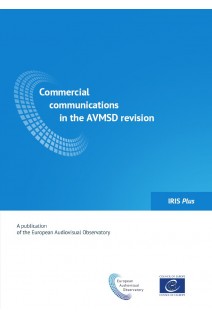

IRIS Special - New Forms of Commercial Communications in a Converged... (2015)
- Online only


An inventory of the online advertising market and its evolution
As technology grows, so too do highly technologically influenced markets such as the audiovisual market. Already at the time of publishing the IRIS Special on “New forms of commercial communications in a converged audiovisual sector” at the end of 2014,1 the claim for this report was: “Who’s afraid of the big bad data? The face of advertising has changed forever. “Commercial communications” (as they are now known) now exist in an increasingly converged media universe. As a result, the lines between real content and advertising are increasingly unclear.”
This is even truer today, as we face the emergence of a digital duopoly with Google and Facebook representing up to 85% of all digital advertising market growth in 2016 and the many challenges the whole industry has to address as a consequence. One of these is certainly the future of traditional advertising-financed media companies, such as commercial TV channels, newspapers and magazines which have a far more limited audience reach. A connected issue is the role of data, which has become the most valuable resource in the online economy, and which is also causing new social divide issues between citizens who can pay for the services and others who pay for them by providing their personal data and allowing themselves to be exposed to advertising. At the same time, consumers are becoming more demanding and are starting to reject interruptive advertising formats, which has in turn led advertisers and media companies to rethink how to capture attention.
Against these market realities, legislation is undergoing a significant revision process with the reform of the Audiovisual Media Services Directive (AVMSD).
1. Setting the scene
1.1. Introduction
1.2. Current challenges facing the digital advertising ecosystem
1.2.1. The emergence of a digital duopoly
1.2.2. What future for traditional advertising-financed media companies?
1.2.3. The role of data and the rising concerns about consumers’ digital privacy
1.2.4. Increased rejection by consumers of interruptive digital ad formats
1.2.5. The concern for brand safety and advertising fraud
1.2.6. Foreseen developments in the advertising sector
1.3. Concluding remarks
2. European framework
2.1. The Audiovisual Media Services Directive
2.1.1. Definition of audiovisual commercial communications
2.1.2. General rules for audiovisual commercial communications
2.1.3. Television advertising and teleshopping
2.1.4. Sponsorship and product placement
2.2. Directives mentioned in the AVMSD
2.2.1. Unfair Commercial Practices Directive
2.2.2. Tobacco Advertising Directive
2.2.3. Directive concerning Medicinal Products for Human Use
2.2.4. Directive concerning Misleading and Comparative Advertising
2.3. Other AVMSD relevant directives
2.3.1. e-Commerce Directive
3. National transposition
3.1. Implementation of general qualitative restrictions
3.2. Implementation of the stricter qualitative restrictions applicable to sponsorship and product placement
3.3. Implementation of the quantitative restrictions applicable to linear transmissions
3.3.1. Diverging interpretative issues of key concepts
3.3.2. Implementation of the 12-minute rule
4. Self and co-regulation
4.1. International standards of self- and co-regulation in the advertising sector
4.2. EU promotion of self and co-regulation in the advertising sector
4.2.1. General obligation of promotion under EU law
4.2.2. Self and co-regulation in commercial communications of specific products
4.2.3. Overview of self and co-regulatory schemes in commercial communications in the EU-28
5. Case law
5.1. European Court of Human Rights
5.2. Court of Justice of the European Union
5.2.1. Audiovisual Media Services Directive
5.2.2. Tobacco Advertising Directive
5.2.3. Misleading and Comparative Advertising Directive
5.3. Overview at member state level
6. State of play
6.1. The revision proposal of the European Commission
6.2. The amendments proposed by the European Parliament and the Council
6.2.1. Definitions and general principles (Articles 1 and 9 AVMSD)
6.2.2. Advertising and teleshopping (Articles 19-24 AVMSD)
6.2.3. Sponsorship and product placement (Articles 10 and 11 AVMSD)
6.3. Next steps
7. Annexes



An inventory of the online advertising market and its evolution
As technology grows, so too do highly technologically influenced markets such as the audiovisual market. Already at the time of publishing the IRIS Special on “New forms of commercial communications in a converged audiovisual sector” at the end of 2014,1 the claim for this report was: “Who’s afraid of the big bad data? The face of advertising has changed forever. “Commercial communications” (as they are now known) now exist in an increasingly converged media universe. As a result, the lines between real content and advertising are increasingly unclear.”
This is even truer today, as we face the emergence of a digital duopoly with Google and Facebook representing up to 85% of all digital advertising market growth in 2016 and the many challenges the whole industry has to address as a consequence. One of these is certainly the future of traditional advertising-financed media companies, such as commercial TV channels, newspapers and magazines which have a far more limited audience reach. A connected issue is the role of data, which has become the most valuable resource in the online economy, and which is also causing new social divide issues between citizens who can pay for the services and others who pay for them by providing their personal data and allowing themselves to be exposed to advertising. At the same time, consumers are becoming more demanding and are starting to reject interruptive advertising formats, which has in turn led advertisers and media companies to rethink how to capture attention.
Against these market realities, legislation is undergoing a significant revision process with the reform of the Audiovisual Media Services Directive (AVMSD).
Please note that in accordance with our terms & conditions, PDF/epubs may only be purchased by private individuals.
